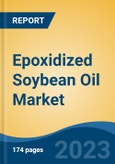Free Webex Call
The Epoxidized Soybean Oil Market was valued at USD 477.42 Million in 2024, and is expected to reach USD 646.80 Million by 2030, rising at a CAGR of 5.15%. Epoxidized soybean oil (ESBO) is produced through the epoxidation of soybean oil, where double bonds in the oil molecules are converted into epoxy groups using hydrogen peroxide and either acetic or formic acid. This process yields a non-toxic, chemically reactive compound widely appreciated for its environmental friendliness and versatility. Speak directly to the analyst to clarify any post sales queries you may have.
10% Free customizationThis report comes with 10% free customization, enabling you to add data that meets your specific business needs.
ESBO is primarily used as a green plasticizer and stabilizer in PVC production, supporting various applications across indoor and outdoor sectors. The reactive epoxy groups in ESBO enhance its functionality in monomer and polymer preparations. Its compatibility with stabilization processes, especially in delaying polyene formation and hydrochloric acid removal, adds further value to its industrial utility. As sustainability and regulatory compliance become more prominent in material selection, ESBO continues to gain traction across multiple end-use industries.
Key Market Drivers
Growing Demand of Epoxidized Soybean Oil in Food Packaging
Epoxidized soybean oil is increasingly being used as a plasticizer and stabilizer in PVC plastics applied in food packaging due to its non-toxic and bio-based nature. ESBO improves the flexibility and performance of packaging materials while meeting consumer demand for safer, more sustainable options. As clean-label and eco-conscious products gain momentum, manufacturers are prioritizing bio-based alternatives to petroleum-derived plasticizers. Regulatory support from agencies such as the US FDA and EFSA further reinforces ESBO’s suitability for food contact applications, enhancing its acceptance in global markets. This rising demand for safe and high-quality packaging is a key driver of ESBO adoption.Key Market Challenges
Lack in Supply of Raw Materials
The production of epoxidized soybean oil is heavily reliant on the availability of soybean oil, making the market vulnerable to fluctuations in soybean yields. Weather conditions, pest infestations, and inconsistent agricultural practices can significantly disrupt supply, while the geographic concentration of soybean production in regions like the US, Brazil, and Argentina introduces additional risks. Political instability, trade restrictions, or natural disasters in these key regions can affect global supply chains, potentially leading to shortages or price volatility. Moreover, logistical constraints in transporting soybeans internationally further exacerbate the supply-side challenges faced by ESBO producers.Key Market Trends
Growing Demand for Sustainable and Bio-based Products
Amid global efforts to transition to greener alternatives, epoxidized soybean oil has gained momentum as a sustainable plasticizer in multiple industries, including adhesives, automotive, and packaging. As consumers and businesses become increasingly environmentally conscious, the preference for bio-based inputs like ESBO is shifting from niche to mainstream. The product’s biodegradability, non-toxic profile, and regulatory acceptance position it as a preferred solution over conventional, petroleum-derived plasticizers. The increasing adoption of sustainable products, along with supportive government policies and industry standards, is expected to fuel continued demand for ESBO in the coming years.Key Market Players
- CHS Inc.
- Arkema SA
- DOW Chemical Company
- Galata Chemicals Inc.
- Hairma Chemicals Ltd.
- Shandong Longkou Longda Chemical Industry Co., Ltd
- Ferro Corporation
- InbraIndustriasQuimicas Ltd.
- Makwell Plasticizers Pvt. Ltd.
- Adeka Corporation
Report Scope:
In this report, the Global Epoxidized Soybean Oil Market has been segmented into the following categories, in addition to the industry trends which have also been detailed below:Epoxidized Soybean Oil Market, By Raw Material:
- Soybean Oil
- Hydrogen Peroxide
- Others
Epoxidized Soybean Oil Market, By End User:
- Food & Beverage
- Personal & Healthcare
- Adhesives & Sealants
- Automotive
- Others
Epoxidized Soybean Oil Market, By Region:
- North America
- United States
- Canada
- Mexico
- Europe
- France
- United Kingdom
- Italy
- Germany
- Spain
- Asia-Pacific
- China
- India
- Japan
- Australia
- South Korea
- South America
- Brazil
- Argentina
- Colombia
- Middle East & Africa
- South Africa
- Saudi Arabia
- UAE
Competitive Landscape
Company Profiles: Detailed analysis of the major companies present in the Global Epoxidized Soybean Oil Market.Available Customizations:
With the given market data, the publisher offers customizations according to a company's specific needs. The following customization options are available for the report.Company Information
- Detailed analysis and profiling of additional market players (up to five).
This product will be delivered within 1-3 business days.
Table of Contents
1. Product Overview
2. Research Methodology
3. Executive Summary
4. Global Epoxidized Soybean Oil Market Outlook
5. Asia Pacific Epoxidized Soybean Oil Market Outlook
6. Europe Epoxidized Soybean Oil Market Outlook
7. North America Epoxidized Soybean Oil Market Outlook
8. South America Epoxidized Soybean Oil Market Outlook
9. Middle East and Africa Epoxidized Soybean Oil Market Outlook
10. Market Dynamics
11. Market Trends & Developments
13. Porter’s Five Forces Analysis
14. Competitive Landscape
Companies Mentioned
- CHS Inc.
- Arkema SA
- DOW Chemical Company
- Galata Chemicals Inc.
- Hairma Chemicals Ltd.
- Shandong Longkou Longda Chemical Industry Co., Ltd
- Ferro Corporation
- InbraIndustriasQuimicas Ltd.
- Makwell Plasticizers Pvt. Ltd.
- Adeka Corporation
Table Information
| Report Attribute | Details |
|---|---|
| No. of Pages | 180 |
| Published | June 2025 |
| Forecast Period | 2024 - 2030 |
| Estimated Market Value ( USD | $ 477.42 Million |
| Forecasted Market Value ( USD | $ 646.8 Million |
| Compound Annual Growth Rate | 5.1% |
| Regions Covered | Global |
| No. of Companies Mentioned | 10 |









